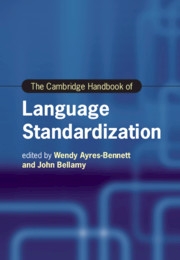Book contents
- The Cambridge Handbook of Language Standardization
- cambridge handbooks in language and linguistics
- The Cambridge Handbook of Language Standardization
- Copyright page
- Contents
- Figures
- Tables
- Contributors
- Introduction
- Part I Revisiting Models and Theories of Language Standardization
- Part II Legitimacy, Authority and the Written Form
- Part III Norms, Literacy and Education
- Part IV Beyond the National
- 19 Transnational Standards of Languages
- 20 Standardization across State Boundaries
- 21 Language Modernization in the Chinese Character Cultural Sphere
- 22 Linguistic Norms, Centre–Periphery Dynamics and the Tension between Uniformity and Diversity in Processes of Standardization
- 23 When Ethnic Boundaries and Language Boundaries Mismatch
- 24 The Standardization of a Stateless Language
- Part V Standardization in Late Modernity
- Name Index
- Subject Index
- References
22 - Linguistic Norms, Centre–Periphery Dynamics and the Tension between Uniformity and Diversity in Processes of Standardization
from Part IV - Beyond the National
Published online by Cambridge University Press: 01 July 2021
- The Cambridge Handbook of Language Standardization
- cambridge handbooks in language and linguistics
- The Cambridge Handbook of Language Standardization
- Copyright page
- Contents
- Figures
- Tables
- Contributors
- Introduction
- Part I Revisiting Models and Theories of Language Standardization
- Part II Legitimacy, Authority and the Written Form
- Part III Norms, Literacy and Education
- Part IV Beyond the National
- 19 Transnational Standards of Languages
- 20 Standardization across State Boundaries
- 21 Language Modernization in the Chinese Character Cultural Sphere
- 22 Linguistic Norms, Centre–Periphery Dynamics and the Tension between Uniformity and Diversity in Processes of Standardization
- 23 When Ethnic Boundaries and Language Boundaries Mismatch
- 24 The Standardization of a Stateless Language
- Part V Standardization in Late Modernity
- Name Index
- Subject Index
- References
Summary
We propose a theoretical reflection on the functions of linguistic norms and the tensions between the linguistic centre(s) and peripheries for any language that has undergone standardization. We propose that dialects have a right to be recognized in the language’s codified norms because of the impact that standardization has on (peripheral) speakers’ perceptions of, and feelings towards, their own varieties. To illustrate these ideas, we use the case of the Catalan language, which has undergone a complex and still incomplete process of standardization since the beginning of the twentieth century. After describing Catalan’s current sociolinguistic situation, we analyse the recent Gramàtica de la llengua catalana (2016) by the Institut d’Estudis Catalans (GIEC). The volume approaches linguistic codification as a process of ‘prescription through description’.
Keywords
- Type
- Chapter
- Information
- The Cambridge Handbook of Language Standardization , pp. 597 - 620Publisher: Cambridge University PressPrint publication year: 2021

